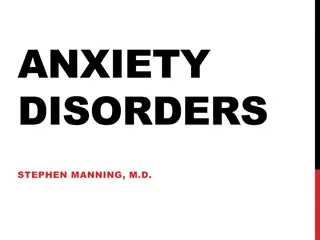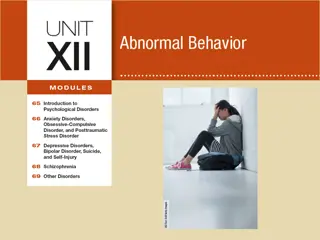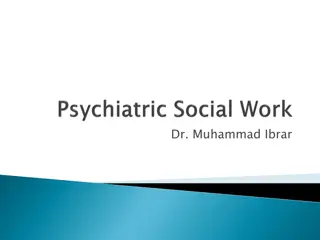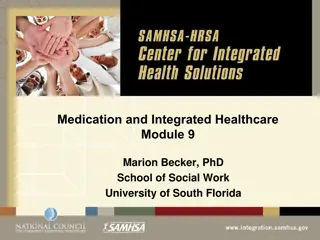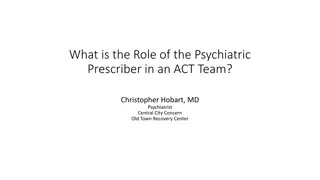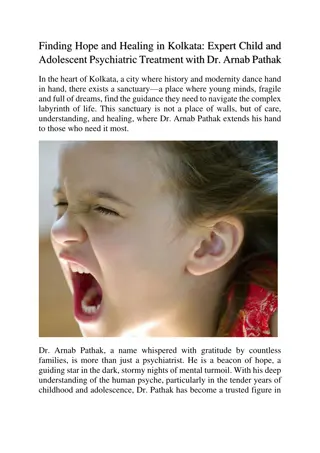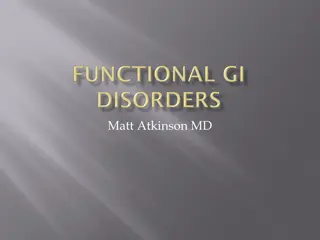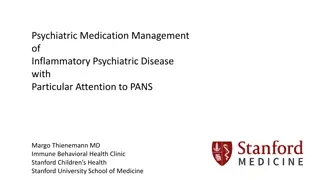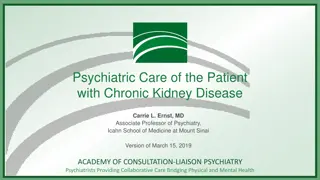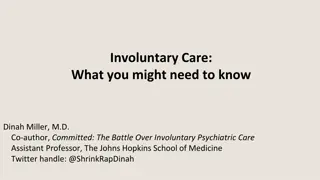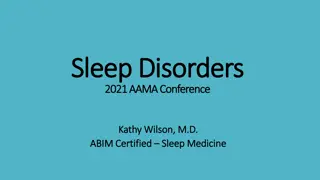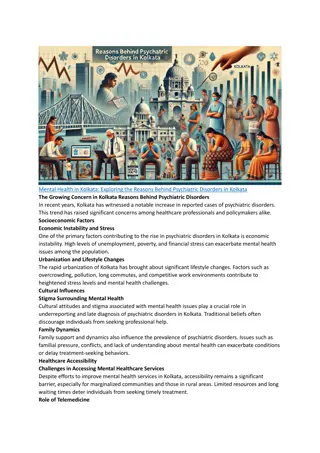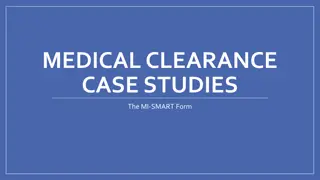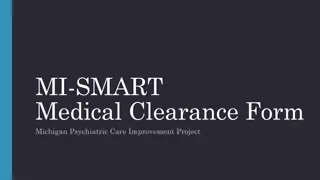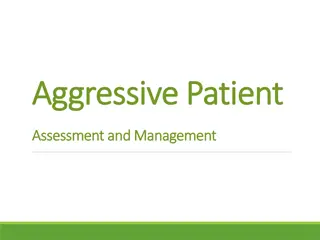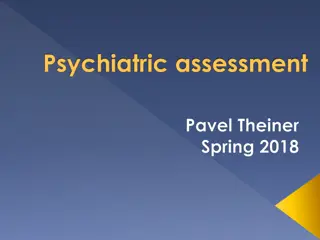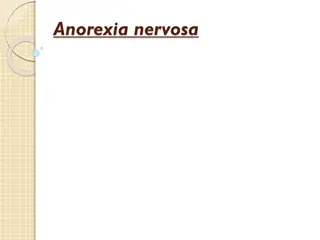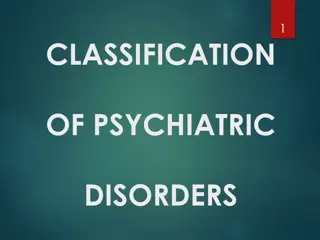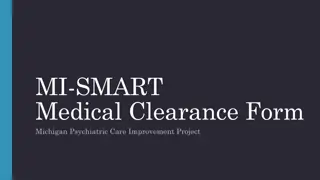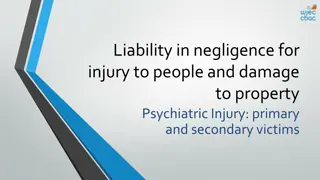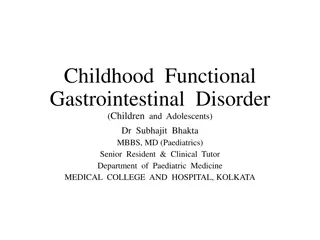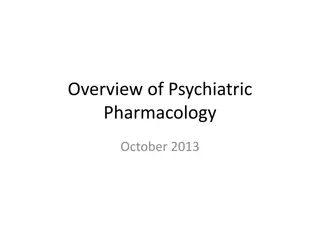
Mood Disorders and Their Impact on Mental Health
Explore the nuances of mood disorders such as major depressive disorder, bipolar disorder, dysthymia, and cyclothymia, understanding their symptoms, differences, and effects on mental health. Gain insights into recognizing signs and seeking appropriate help to manage these conditions effectively.
Download Presentation

Please find below an Image/Link to download the presentation.
The content on the website is provided AS IS for your information and personal use only. It may not be sold, licensed, or shared on other websites without obtaining consent from the author. If you encounter any issues during the download, it is possible that the publisher has removed the file from their server.
You are allowed to download the files provided on this website for personal or commercial use, subject to the condition that they are used lawfully. All files are the property of their respective owners.
The content on the website is provided AS IS for your information and personal use only. It may not be sold, licensed, or shared on other websites without obtaining consent from the author.
E N D
Presentation Transcript
Mood is a pervasive and sustained feeling tone that is experienced internally and that influences a person's behavior and perception of the world. Affect is the external expression of mood. Mood can be normal, elevated, or depressed. Healthy persons experience a wide range of moods and have an equally large repertoire of affective expressions; they feel in control of their moods and affects. Mood disorders are a group of clinical conditions characterized by a loss of that sense of control and a subjective experience of great distress.
Major depressive disorder (MDD) or unipolar depression is a disorder with only major depressive episodes, without a history of a manic, mixed, or hypomanic episode.
Bipolar disorder Bipolar I disorder is a disorder with one or more manic episodes, and sometimes major depressive episodes. Bipolar II disorder is a disorder with episodes of major depression and hypomania rather than mania.
Dysthymia (dysthymic disorder) is characterized by at least 2 years of depressed mood that is not sufficiently severe to fit the diagnosis of major depressive episode. It represents less severe form of major depression. Cyclothymia (cyclothymic disorder) is characterized by at least 2 years of frequently occurring hypomanic symptoms that cannot fit the diagnosis of manic episode and of depressive symptoms that cannot fit the diagnosis of major depressive episode. It represents a less severe form of bipolar disorder.
Minor depressive disorder Recurrent brief depressive disorder
Five (or more) of the following symptoms have been present during the same 2-week period and represent a change from previous functioning; at least one of the symptoms is either (1) depressed mood or (2) loss of interest or pleasure. Note: Do not include symptoms that are clearly due to a general medical condition, or mood- incongruent delusions or hallucinations. depressed mood most of the day, nearly every day, as indicated by either subjective report (e.g., feels sad or empty) or observation made by others (e.g., appears tearful). Note: In children and adolescents, can be irritable mood markedly diminished interest or pleasure in all, or almost all, activities most of the day, nearly every day (as indicated by either subjective account or observation made by others) significant weight loss when not dieting or weight gain (e.g., a change of more than 5% of body weight in a month), or decrease or increase in appetite nearly every day. Note: In children, consider failure to make expected weight gains. insomnia or hypersomnia nearly every day psychomotor agitation or retardation nearly every day (observable by others, not merely subjective feelings of restlessness or being slowed down) fatigue or loss of energy nearly every day feelings of worthlessness or excessive or inappropriate guilt (which may be delusional) nearly every day (not merely self-reproach or guilt about being sick) diminished ability to think or concentrate, or indecisiveness, nearly every day (either by subjective account or as observed by others) recurrent thoughts of death (not just fear of dying), recurrent suicidal ideation without a specific plan, or a suicide attempt or a specific plan for committing suicide
Social/occupational dysfunction. Exclusion of mixed episode. Exclusion of substance/general medical condition. Exclusion of bereavement (The symptoms are not better accounted for by bereavement, i.e., after the loss of a loved one, the symptoms persist for longer than 2 months or are characterized by marked functional impairment, morbid preoccupation with worthlessness, suicidal ideation, psychotic symptoms, or psychomotor retardation.)
A distinct period of abnormally and persistently elevated, expansive, or irritable mood, lasting at least 1 week (or any duration if hospitalization is necessary). During the period of mood disturbance, three (or more) of the following symptoms have persisted (four if the mood is only irritable) and have been present to a significant degree: inflated self-esteem or grandiosity decreased need for sleep (e.g., feels rested after only 3 hours of sleep) more talkative than usual or pressure to keep talking flight of ideas or subjective experience that thoughts are racing distractibility (i.e., attention too easily drawn to unimportant or irrelevant external stimuli) increase in goal-directed activity (either socially, at work or school, or sexually) or psychomotor agitation excessive involvement in pleasurable activities that have a high potential for painful consequences (e.g., engaging in unrestrained buying sprees, sexual indiscretions, or foolish business investments)
Social/occupational dysfunction. Exclusion of mixed episode. Exclusion of substance/general medical condition. Note: Manic-like episodes that are clearly caused by somatic antidepressant treatment (e.g., medication, electroconvulsive therapy, light therapy) should not count toward a diagnosis of bipolar I disorder.
A distinct period of persistently elevated, expansive, or irritable mood, lasting throughout at least 4 days, that is clearly different from the usual nondepressed mood. During the period of mood disturbance, three (or more) of the following symptoms have persisted (four if the mood is only irritable) and have been present to a significant degree: inflated self-esteem or grandiosity decreased need for sleep (e.g., feels rested after only 3 hours of sleep) more talkative than usual or pressure to keep talking flight of ideas or subjective experience that thoughts are racing distractibility (i.e., attention too easily drawn to unimportant or irrelevant external stimuli) increase in goal-directed activity (either socially, at work or school, or sexually) or psychomotor agitation excessive involvement in pleasurable activities that have a high potential for painful consequences (e.g., the person engages in unrestrained buying sprees, sexual indiscretions, or foolish business investments)
The episode is associated with an unequivocal change in functioning that is uncharacteristic of the person when not symptomatic. The disturbance in mood and the change in functioning are observable by others. The episode is not severe enough to cause marked impairment in social or occupational functioning, or to necessitate hospitalization, and there are no psychotic features. Exclusion of substance/general medical condition. Note: Hypomanic-like episodes that are clearly caused by somatic antidepressant treatment (e.g., medication, electroconvulsive therapy, light therapy) should not count toward a diagnosis of bipolar II disorder.
Psychosocial Therapies (psychotherapy) Cognitive therapy Behavior therapy Biological therapies Pharmacotherapy Antidepressant Medications Augmentation drugs: lithium, antiepileptics, antipsychotics, thyroid ECT Vagal Nerve Stimulation Sleep Deprivation Phototherapy
MAO inhibitors (Tranylcypromine) Tricyclic antidepressnats (Clomipramine, Imipramine, Amitryptyline, Dothiepin,Tianeptine) Selective serotonin reuptake inhibitors (Citalopram, Escitalopram, Fluoxetine,Paroxetine, Sertraline, Fluvoxamine) Serotonin norepinephrine reuptake inhibitors (Venlafaxine, Duloxetine) Norepinephrine reuptake inhibitors (Reboxetine) Atypical antidepressants (Mirtazapine, Bubrobione, Trazodone)
The pharmacological treatment of bipolar disorders is divided into both Treatment of acute episode Treatment of acute mania or hypomania Treatment of acute depression Maintenance treatment
Lithium Carbonate Antieplieptic drugs (Valproate, Carbamazepine, Oxcarba-zepine, Clonazepam & Lorazepam) Anti-psychotics (Atypical & Typical) ECT
Standard anti-depressants + mood stabilizer Mood stabilizers ECT
Lithium Carbonate Antieplieptic drugs (Valproate, Carbamazepine, Lamotrigine) Anti-psychotics (Olanzapine) Thyroid supplementation

